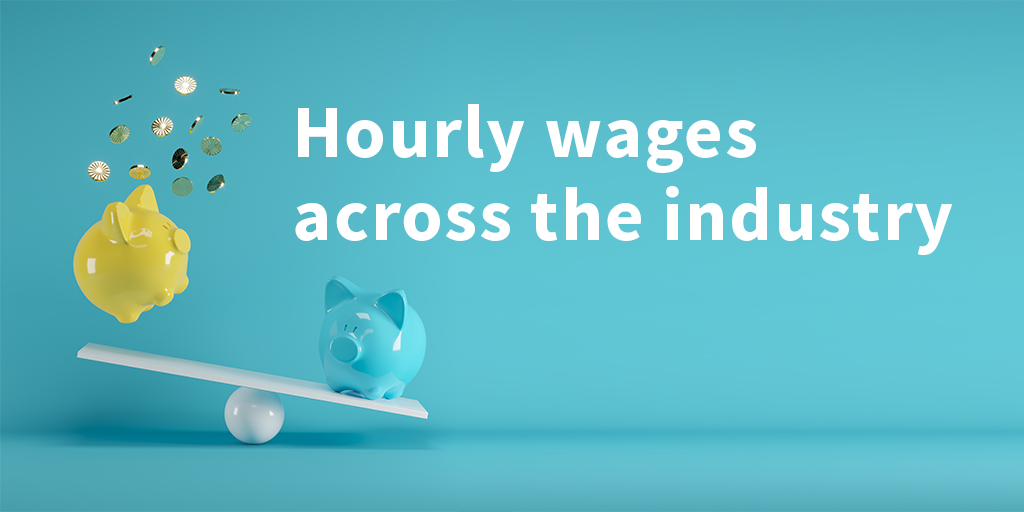A wage increase is cooking up in the state of California. The Golden State's minimum hourly rate will jump from $15.50 to $16.00 starting January 1st, 2024 according to the state's Department of Finance Director Joe Stephenshaw (View our California hourly wage index for more information). The 50 cent increase was announced on July 31st, 2023 and will help hourly workers better weather the high cost of living in California.
The impact on wages won't be limited to your favorite burger joints either; it’s going across the board from Los Angeles diners right through San Francisco coffee shops (Federal Minimum Wage Information). No matter how sizzling the grills get or how busy the lunch rush is, this hike ensures that every minute spent flipping burgers or making coffees counts even more towards achieving financial stability.
On top of the wage changes that are surely happening, a new deal between labor and industry would potentially bump that $15.50 per hour all the way up to $20.00 per hour. This mandatory wage bump would impact all fast food restaurants in California that are part of a chain with at least 60 locations across the nation. This bill must be pending and comes down to the state legislature but hourly workers across the state are surely hopeful for the change.
Impact On The Broader Fast-Food Industry
Now here's some food for thought: what does this mean for those beyond individual workers? Well, small businesses may need to adjust their budgets while big corporations could see an uptick in labor costs - but hey, happy staff often equals happier customers. This wage boost isn’t just staying within state lines either as other states are likely watching closely too. Will they follow suit with similar changes or will they continue down their own wage path?
Impact on Small Businesses and Preparations for Wage Increases
Small businesses are typically the most vulnerable to any increase in minimum wage. Unlike large corporations, they may not have a cushion to soften the financial impact of higher labor costs.
No Relief or Grace Period for Small Businesses
The upcoming hike in California's minimum wage offers no grace period for small businesses. This means there's little time to adjust budgets and strategies. As daunting as this might sound, don't panic. With careful planning and some smart moves, you can prepare your business to weather these changes.
An essential first step is reviewing your budget and financial records carefully. It sounds basic but knowing where every dollar goes will help you find areas where savings can be made without compromising quality or service levels.
A tip from our firsthand experience: consider cross-training employees so they're equipped with multiple skills. This could let them handle more tasks efficiently - a move that ultimately saves money.
You might also want to think about automation wherever possible. Streamlining processes using technology could save valuable man-hours which translates into dollars saved in wages paid out. By the way, Workstream helps alleviate a lot of this automation stress.
"If I had one piece of advice for fellow small business owners," says Jim Collins, who runs a bakery chain across San Francisco "it would be this: stay informed about changing regulations."
In conclusion, while increased wages do pose challenges especially if you run a small venture; staying informed and proactive planning can turn it around.
Comparing California's Minimum Wage to Other States
Attempting to make it on fifty thousand dollars annually in California can be a daunting task. With the cost of living and taxes sky-high compared to other states, your dollar just doesn't stretch as far. Our hourly wage index can help break down wage information in all states but for this exersise let's focus on the great state of South Carolina.
But let's take this into perspective. In South Carolina, the minimum wage is identical to the federal rate of $7.25 per hour - a figure that may seem meagre in comparison with California's rate but which must be taken into account when considering our state’s notoriously expensive cost of living. That sounds low when stacked against California's hefty hourly rate but remember - it’s all relative.
The real bite comes from our state’s infamous cost of living which is one of the highest in America. In Los Angeles for example, that same wage would need to be significantly higher just for workers to have comparable purchasing power.
This stark difference between wages and costs makes earning a 'living wage' tough even with our progressive laws leading us towards higher minimums.
High Cost of Living in California
In cities like San Francisco or Los Angeles, expenses are astronomical. Everything from rent prices to groceries takes more out of your paycheck than almost anywhere else in the U.S., despite having some local ordinances pushing wages above statewide levels.
Surely enough, though every Californian dreams about sun-soaked beaches and perfect weather 365 days a year - these perks come at quite a price. But hey, who said anything about paradise being cheap?
Future Predictions for Minimum Wage in California
The future of minimum wage in the Golden State has been a hot topic, especially considering inflation and other economic factors. The Director's role is crucial as they are tasked with adjusting wages based on these elements.
Inflation plays an essential part here because it directly impacts purchasing power. If prices rise faster than wages, workers find it harder to make ends meet despite wage increases. So, we could expect more adjustments to the state's minimum wage if inflation continues its upward trend.
This approach makes sense when you think about it like this: You wouldn't keep using your old umbrella during a rainstorm if it had holes in it and was no longer keeping you dry - you'd get a new one. If the present minimum wage doesn't suffice in light of increasing expenses, then a boost is required.
Predicting exact numbers can be challenging though; just like trying to guess what color shirt your neighbor will wear tomorrow (good luck with that.). But looking at trends can give us some idea. For example, South Carolina recently announced a deal regarding their own minimum annual salary increase – something that might hint towards similar moves elsewhere too.
If we look back over time, there have been consistent increments since 2007 where California’s Department raised the hourly rate from $8 per hour up till now at $15 per hour or even higher for local ordinances. Given such history, one thing seems certain: With ever-changing economic conditions including consumer price indices factored into calculations - don’t bet against another bump soon.
Conclusion
We've explored the state, federal, and local laws that dictate these rates. Through our journey, we saw how inflation plays a crucial role in setting wages. The differences between local ordinances across cities became apparent too. We peered into fast food workers' upcoming pay raises and pondered over the challenges small businesses face due to this increase. Yet amidst it all, they remain resilient by preparing well ahead of time.
A broader perspective revealed California's higher-than-average wage compared with other states; yet the high cost of living remains an uphill battle for many earning at or near minimum wage levels. In looking forward, let’s not forget predictions indicate further increases based on economic factors like inflation.





